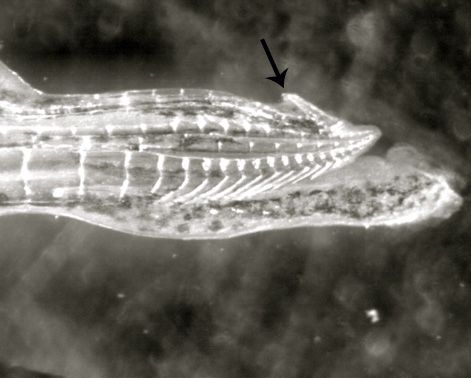Hooked! Male Fish Lure Females With Genital Claws

When male guppies fail to win over females with their good looks and dance moves, they turn to another, more aggressive set of tools: claws on the tips of their genitalia.
Biologists have long speculated that guppies — freshwater fish native to the Caribbean — use tiny claws on the tips of their genitalia to secure mates. But, until now, nobody has tested this theory experimentally. A group of biologists from the University of Toronto conducted an experiment to test the role of the claws in mating, and found that the grippers helped males seal the deal with females that were otherwise unwilling to mate, the researchers report today (July 23) in the journal Biology Letters.
At first, male guppies take on a peaceful approach to mating and put on a bit of a show to attract females. When they are lucky, the females willingly approach them when the show is over. [Top 10 Swingers in the Animal Kingdom]
"The male will display to the female, extending his body in an S shape and then shimmering, showing these bright spots," said Lucia Kwan, a graduate student at the University of Toronto and a co-author of the report. "If the female is receptive, she glides over to the male."
But, if females don't show interest, males continue to pursue them. They sneak around the female from behind or below, and try to force sperm into her without her cooperation. This behavior is common in guppies in the wild, Kwan said.
To test the role of claws in this mating tactic, the team used a scalpel to slice off the claws from a subset of test guppies, leaving the claws intact in the rest of the test group for comparison. They then placed each male in a tank with a virgin female and waited up to two hours to observe mating behavior. At the end of each trial, the team extracted the females from the tanks and dissected them, removing and quantifying the amount of sperm within each female.
The team found that clawed males transferred up to three times more sperm to females than declawed males did during forced matings. However, in cases in which females actively approached the males, both clawed and declawed males had comparable success. This finding suggests the claws may help the males tighten their grip on squirming, uncooperative females, but are otherwise not necessary for sperm transfer.
Sign up for the Live Science daily newsletter now
Get the world’s most fascinating discoveries delivered straight to your inbox.
Other fish related to the guppy have similar gripping tools on the tips of their genitalia, including hooks and spines. The team hopes to explore the roles of these other structures — some of which appear only in certain individuals within a species — to better understand their evolutionary advantages in sexual selection.
"We see these patterns, but we are still unaware of which [evolutionary] mechanisms are driving them," Kwan told LiveScience.
The team hopes this work will help explain why fish genitalia vary so greatly across species.
Editor’s Note: This story has been updated to correct the journal that this study appeared in. The study appeared in the journal Biology Letters, not the Proceedings of the Royal Society B.
Follow Laura Poppick on Twitter. Follow LiveScience on Twitter, Facebook and Google+. Original article on LiveScience.











